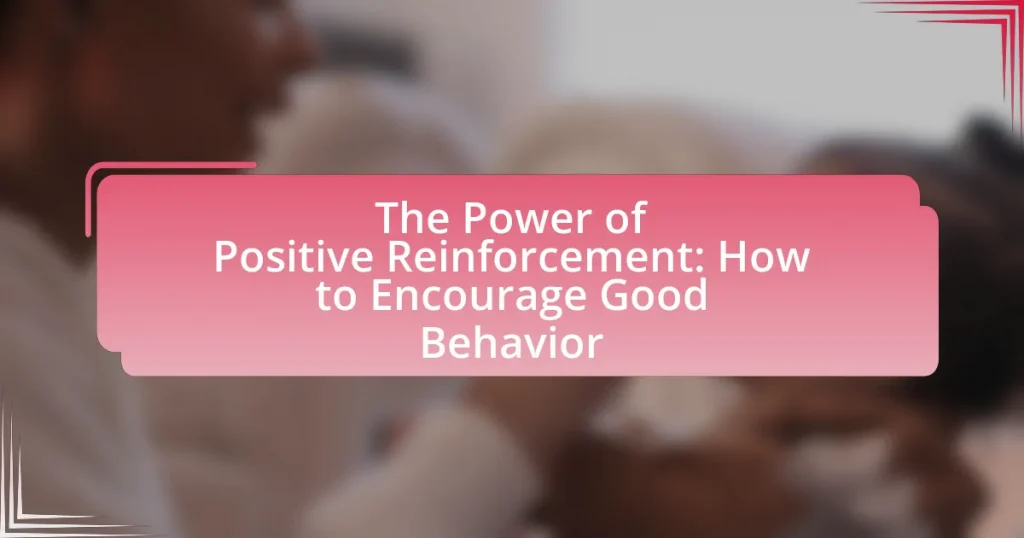The article focuses on the concept of positive reinforcement, a psychological principle that enhances the likelihood of desired behaviors through rewards or positive feedback. It explores how positive reinforcement influences behavior, the key principles that underpin its effectiveness, and the differences between positive and negative reinforcement. Additionally, the article discusses the impact of positive reinforcement on motivation and engagement, the various types of reinforcement, and practical strategies for implementing it in educational and home settings. It also addresses potential challenges and best practices for ensuring that positive reinforcement is meaningful and effective in encouraging good behavior.

What is the Power of Positive Reinforcement?
The power of positive reinforcement lies in its ability to increase the likelihood of desired behaviors by providing rewards or positive feedback following those behaviors. This psychological principle is grounded in operant conditioning, where behaviors followed by favorable outcomes are more likely to be repeated. Research indicates that positive reinforcement can lead to improved performance and motivation; for instance, a study published in the Journal of Applied Behavior Analysis found that children who received praise for good behavior exhibited a significant increase in that behavior compared to those who did not receive reinforcement.
How does positive reinforcement influence behavior?
Positive reinforcement influences behavior by increasing the likelihood of a desired behavior being repeated. When an individual receives a reward or positive outcome following a specific action, it strengthens the association between the behavior and the positive consequence. For example, studies show that children who receive praise for completing their homework are more likely to continue doing their homework in the future, as evidenced by research conducted by Skinner in the 1950s, which demonstrated that behaviors followed by positive outcomes are reinforced and thus more likely to recur.
What are the key principles of positive reinforcement?
The key principles of positive reinforcement include the immediate delivery of a reward following a desired behavior, the consistency of reinforcement to strengthen the behavior, and the use of meaningful rewards that are valued by the individual. Immediate reinforcement helps to create a clear connection between the behavior and the reward, making it more likely that the behavior will be repeated. Consistency in reinforcement ensures that the individual understands which behaviors are being rewarded, thereby increasing the likelihood of those behaviors occurring again. Additionally, using rewards that are meaningful to the individual enhances motivation and engagement, as demonstrated in studies showing that personalized rewards lead to higher rates of behavior reinforcement.
How does positive reinforcement differ from negative reinforcement?
Positive reinforcement involves adding a desirable stimulus to increase a behavior, while negative reinforcement entails removing an aversive stimulus to enhance a behavior. For example, giving a child praise for completing homework is positive reinforcement, as it encourages the child to repeat the behavior. In contrast, allowing a student to skip a difficult assignment after demonstrating good behavior is negative reinforcement, as it removes an unpleasant task to promote future compliance. Both methods aim to strengthen behavior, but they operate through different mechanisms of reward and relief.
Why is positive reinforcement effective in encouraging good behavior?
Positive reinforcement is effective in encouraging good behavior because it increases the likelihood of a desired behavior being repeated by providing a rewarding stimulus following that behavior. Research indicates that when individuals receive positive feedback or rewards, such as praise or tangible rewards, they are more motivated to engage in the behavior again. For instance, a study published in the Journal of Applied Behavior Analysis found that children who received positive reinforcement for completing tasks were significantly more likely to repeat those tasks in the future. This demonstrates that positive reinforcement not only acknowledges good behavior but also strengthens the association between the behavior and the positive outcome, leading to a higher frequency of the desired behavior over time.
What psychological theories support the effectiveness of positive reinforcement?
Behaviorism and operant conditioning are the primary psychological theories that support the effectiveness of positive reinforcement. Behaviorism, founded by B.F. Skinner, posits that behaviors can be shaped through reinforcement, where positive outcomes increase the likelihood of a behavior being repeated. Skinner’s experiments demonstrated that animals, such as rats and pigeons, would perform tasks to receive rewards, illustrating the principle that positive reinforcement strengthens behavior. Additionally, the Premack Principle, proposed by David Premack, suggests that more probable behaviors can reinforce less probable behaviors, further validating the effectiveness of positive reinforcement in behavior modification.
How does positive reinforcement impact motivation and engagement?
Positive reinforcement significantly enhances motivation and engagement by providing rewards or positive feedback that encourages desired behaviors. When individuals receive positive reinforcement, such as praise or tangible rewards, they are more likely to repeat the behavior that led to the reinforcement, thereby increasing their overall motivation. Research by Skinner (1953) on operant conditioning demonstrates that behaviors followed by positive outcomes are strengthened, leading to higher engagement levels in tasks. Additionally, a study published in the Journal of Applied Psychology found that employees who received positive reinforcement reported greater job satisfaction and commitment, further illustrating the direct correlation between positive reinforcement, motivation, and engagement.

What are the different types of positive reinforcement?
The different types of positive reinforcement include tangible rewards, social reinforcement, and intrinsic reinforcement. Tangible rewards involve providing physical items, such as toys or treats, to encourage desired behaviors. Social reinforcement consists of verbal praise, attention, or approval from others, which can motivate individuals to repeat positive actions. Intrinsic reinforcement occurs when the behavior itself provides satisfaction or pleasure, leading to a natural desire to engage in that behavior again. These types of positive reinforcement are supported by behavioral psychology, which emphasizes their effectiveness in shaping and encouraging good behavior.
How can verbal praise be used as a form of positive reinforcement?
Verbal praise can be used as a form of positive reinforcement by acknowledging and rewarding desired behaviors, which increases the likelihood of those behaviors being repeated. When individuals receive specific and sincere verbal recognition for their actions, such as “Great job on completing that task,” it reinforces their motivation and encourages them to continue performing well. Research indicates that positive reinforcement, including verbal praise, can enhance self-esteem and promote a positive learning environment, as demonstrated in studies by Skinner and others, which show that reinforcement leads to behavior repetition.
What are the benefits of using verbal praise effectively?
Using verbal praise effectively enhances motivation, reinforces positive behavior, and fosters a supportive environment. When individuals receive specific and genuine verbal praise, they are more likely to repeat the praised behavior, as studies indicate that positive reinforcement increases the likelihood of desired actions. For instance, research published in the Journal of Applied Behavior Analysis shows that verbal praise significantly improves task performance and engagement among children. This demonstrates that effective verbal praise not only boosts self-esteem but also encourages a culture of recognition and appreciation, leading to sustained positive behavior over time.
How can verbal praise be tailored to individual needs?
Verbal praise can be tailored to individual needs by personalizing the feedback to align with the recipient’s values, preferences, and specific achievements. For instance, recognizing a child’s effort in a particular subject they are passionate about can enhance their motivation and self-esteem. Research indicates that tailored praise, which acknowledges individual strengths and interests, is more effective in promoting positive behavior and learning outcomes (Henderlong & Lepper, 2002, “The Effects of Praise on Children’s Motivation: A Review and Synthesis”). This approach ensures that the praise resonates with the individual, making it more impactful and reinforcing desired behaviors.
What role do rewards play in positive reinforcement?
Rewards serve as a crucial component in positive reinforcement by providing a desirable outcome that encourages the repetition of specific behaviors. When an individual receives a reward following a behavior, it strengthens the association between the behavior and the positive outcome, making it more likely that the behavior will occur again in the future. Research indicates that rewards can significantly enhance motivation and engagement; for instance, a study published in the Journal of Applied Behavior Analysis found that children who received tangible rewards for completing tasks demonstrated higher rates of task completion compared to those who did not receive rewards. This evidence underscores the effectiveness of rewards in reinforcing desired behaviors and promoting positive outcomes.
What types of rewards are most effective in reinforcing good behavior?
Tangible rewards, such as money, gift cards, or physical items, are most effective in reinforcing good behavior. Research indicates that tangible rewards provide immediate gratification, which can enhance motivation and encourage repeated positive actions. A study published in the Journal of Applied Behavior Analysis found that tangible rewards significantly increased the frequency of desired behaviors in children, demonstrating their effectiveness in various settings. Additionally, social rewards, like praise or recognition, also play a crucial role, as they foster a sense of belonging and validation, further reinforcing good behavior.
How can intrinsic and extrinsic rewards be balanced?
Intrinsic and extrinsic rewards can be balanced by aligning them to complement each other, ensuring that intrinsic motivation is not undermined by extrinsic incentives. For instance, organizations can create a work environment that fosters personal growth and satisfaction while also providing tangible rewards such as bonuses or recognition. Research indicates that when employees perceive extrinsic rewards as a recognition of their intrinsic efforts, motivation increases; a study by Deci, Koestner, and Ryan (1999) found that intrinsic motivation is enhanced when extrinsic rewards are perceived as supportive rather than controlling. Thus, a strategic approach that integrates both types of rewards can lead to improved performance and satisfaction.

How can positive reinforcement be implemented in various settings?
Positive reinforcement can be implemented in various settings by providing rewards or incentives to encourage desired behaviors. In educational settings, teachers can use praise, stickers, or extra credit to motivate students to participate actively and complete assignments. In the workplace, managers can offer bonuses, recognition, or promotions to employees who meet or exceed performance goals, fostering a culture of achievement. In parenting, caregivers can use verbal affirmations or small treats to reinforce positive behaviors in children, such as completing chores or displaying good manners. Research indicates that positive reinforcement increases the likelihood of repeated behaviors, as demonstrated in studies showing improved academic performance and workplace productivity when rewards are utilized effectively.
What strategies can parents use to apply positive reinforcement at home?
Parents can apply positive reinforcement at home by using specific strategies such as offering praise, providing rewards, and establishing a consistent reinforcement schedule. Praising children immediately after they exhibit desired behaviors reinforces those behaviors effectively, as research shows that immediate feedback increases the likelihood of repetition. Providing tangible rewards, such as stickers or extra playtime, can motivate children to engage in positive behaviors, as studies indicate that rewards can enhance motivation and compliance. Additionally, establishing a consistent reinforcement schedule, where positive behaviors are recognized regularly, helps children understand expectations and encourages ongoing good behavior.
How can parents identify and reinforce desired behaviors in children?
Parents can identify and reinforce desired behaviors in children by observing specific actions that align with positive behavior expectations and providing immediate, consistent feedback. For instance, when a child shares toys or helps with chores, parents should acknowledge these actions with praise or rewards, reinforcing the behavior. Research indicates that positive reinforcement increases the likelihood of repeated behaviors; a study published in the Journal of Applied Behavior Analysis found that children are more likely to repeat behaviors that are positively reinforced. This approach not only encourages good behavior but also strengthens the parent-child relationship through positive interactions.
What common mistakes should parents avoid when using positive reinforcement?
Parents should avoid being inconsistent with positive reinforcement, as inconsistency can confuse children about what behaviors are being rewarded. When parents fail to provide reinforcement consistently, children may not understand the connection between their actions and the rewards, leading to frustration and misbehavior. Research indicates that consistent reinforcement strengthens the desired behavior, while inconsistency can undermine the effectiveness of positive reinforcement strategies.
How can teachers effectively use positive reinforcement in the classroom?
Teachers can effectively use positive reinforcement in the classroom by consistently acknowledging and rewarding desired behaviors. This can be achieved through verbal praise, tangible rewards, or special privileges, which reinforce the behavior and encourage its repetition. Research indicates that positive reinforcement can lead to improved student engagement and motivation, as demonstrated in a study by Simonsen et al. (2008), which found that classrooms implementing positive reinforcement strategies saw a significant decrease in disruptive behaviors and an increase in academic performance. By applying these techniques, teachers create a supportive learning environment that fosters positive behavior and enhances overall classroom dynamics.
What are some practical examples of positive reinforcement in education?
Practical examples of positive reinforcement in education include verbal praise, tangible rewards, and recognition systems. Verbal praise, such as saying “Great job!” or “I’m proud of your effort!” encourages students to repeat desired behaviors. Tangible rewards, like stickers or extra recess time, provide immediate incentives for completing assignments or exhibiting good behavior. Recognition systems, such as student of the month awards, foster a sense of achievement and motivate students to strive for excellence. Research indicates that these methods can significantly enhance student engagement and performance, as highlighted in studies by the American Psychological Association, which emphasize the effectiveness of positive reinforcement in promoting desirable behaviors in educational settings.
How can teachers measure the effectiveness of their reinforcement strategies?
Teachers can measure the effectiveness of their reinforcement strategies by tracking student behavior changes and academic performance over time. By collecting data on specific behaviors before and after implementing reinforcement strategies, educators can analyze trends and determine if positive reinforcement leads to desired outcomes. For instance, a study published in the Journal of Applied Behavior Analysis found that consistent reinforcement of positive behaviors resulted in a significant increase in those behaviors among students, demonstrating the effectiveness of such strategies. Additionally, using tools like behavior charts, surveys, and academic assessments can provide concrete evidence of improvement, allowing teachers to adjust their approaches based on measurable results.

What challenges might arise when using positive reinforcement?
Challenges that might arise when using positive reinforcement include the potential for dependency on rewards, inconsistency in application, and the risk of reinforcing undesirable behaviors inadvertently. Dependency on rewards can lead individuals to expect incentives for all positive actions, diminishing intrinsic motivation. Inconsistency in applying positive reinforcement can confuse individuals about what behaviors are being rewarded, leading to frustration and disengagement. Additionally, if positive reinforcement is not carefully managed, it may inadvertently reinforce negative behaviors if the timing or context of the reinforcement is not appropriate. These challenges highlight the need for a structured and thoughtful approach to implementing positive reinforcement strategies.
What are the potential drawbacks of relying solely on positive reinforcement?
Relying solely on positive reinforcement can lead to several drawbacks, including the potential for dependency on rewards and a lack of understanding of intrinsic motivation. When individuals are consistently rewarded for specific behaviors, they may become reliant on external validation, diminishing their ability to engage in those behaviors without rewards. Additionally, this approach may fail to address inappropriate behaviors effectively, as it does not provide corrective feedback or consequences for negative actions. Research indicates that over-reliance on positive reinforcement can result in a lack of resilience and problem-solving skills, as individuals may not learn to cope with challenges or setbacks without the presence of rewards.
How can over-reliance on rewards diminish intrinsic motivation?
Over-reliance on rewards can diminish intrinsic motivation by shifting the focus from the inherent enjoyment of an activity to the external incentives associated with it. When individuals are consistently rewarded for their actions, they may begin to perceive the activity as a means to an end rather than a source of personal satisfaction. Research by Deci, Koestner, and Ryan (1999) in “A Meta-Analytic Review of Experiments Examining the Effects of Extrinsic Rewards on Intrinsic Motivation” indicates that tangible rewards can undermine intrinsic motivation, particularly when they are expected and contingent on performance. This shift can lead to decreased engagement and creativity, as individuals may only participate in the activity for the reward rather than for the joy of the experience itself.
What strategies can be used to mitigate these challenges?
To mitigate challenges in encouraging good behavior through positive reinforcement, implementing consistent reward systems is essential. Consistent reward systems, such as immediate praise or tangible rewards for desired behaviors, reinforce positive actions effectively. Research indicates that immediate reinforcement increases the likelihood of behavior repetition; for instance, a study published in the Journal of Applied Behavior Analysis found that immediate reinforcement significantly improved task completion rates among children. Additionally, incorporating varied reinforcement strategies, such as verbal praise, tokens, or privileges, can cater to individual preferences and enhance motivation. This approach ensures that the reinforcement remains engaging and effective over time.
What are best practices for implementing positive reinforcement effectively?
Best practices for implementing positive reinforcement effectively include providing immediate and specific feedback, ensuring the reinforcement is meaningful to the individual, and maintaining consistency in application. Immediate feedback helps the individual associate the desired behavior with the reward, enhancing learning. Specific feedback clarifies what behavior is being reinforced, making it easier for the individual to replicate it. Additionally, using reinforcers that are personally meaningful increases motivation and engagement. Consistency in applying positive reinforcement ensures that the individual understands the expected behaviors and the rewards associated with them, which is supported by research indicating that consistent reinforcement leads to more reliable behavior change.
How can consistency enhance the effectiveness of positive reinforcement?
Consistency enhances the effectiveness of positive reinforcement by ensuring that desired behaviors are reliably rewarded, which strengthens the association between the behavior and the positive outcome. When reinforcement is applied consistently, individuals are more likely to repeat the behavior because they understand the direct link between their actions and the rewards they receive. Research indicates that consistent reinforcement leads to quicker learning and retention of behaviors, as demonstrated in studies on operant conditioning, where subjects exposed to regular rewards for specific actions showed significantly higher rates of those actions compared to those who received inconsistent reinforcement.
What tips can help ensure positive reinforcement is meaningful and impactful?
To ensure positive reinforcement is meaningful and impactful, it is essential to provide immediate feedback following the desired behavior. Immediate reinforcement strengthens the association between the behavior and the reward, making it more likely to be repeated. Research indicates that timely reinforcement increases the effectiveness of behavior modification strategies, as demonstrated in studies on operant conditioning. Additionally, tailoring the reinforcement to the individual’s preferences enhances its significance; for instance, a child may respond better to verbal praise than a tangible reward. This personalization aligns with findings from behavioral psychology, which emphasize the importance of individual differences in motivation. Lastly, consistency in applying positive reinforcement helps establish clear expectations, reinforcing the desired behavior over time.















